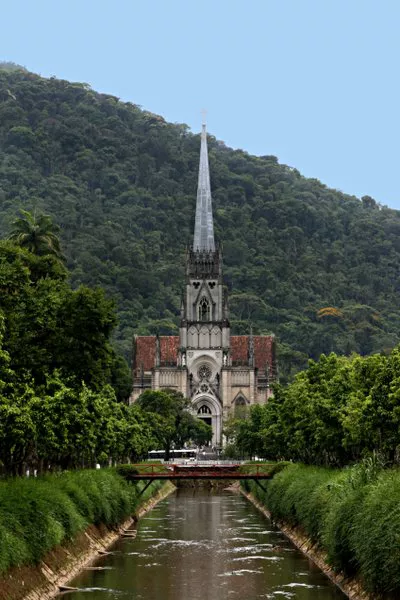Summary
Overview of Petrópolis
Petrópolis, nestled within the Serra Fluminense mountain range in Rio de Janeiro State, serves as a favorite getaway for residents of Rio de Janeiro. It offers cooler weather, historic buildings, numerous ecotourism and adventure opportunities, as well as charming hotels. Recognized as the closest mountain resort to Rio, Petrópolis is often viewed alongside the towns of Teresópolis and Nova Friburgo.
Moreover, sightseeing in Petrópolis is quite accessible, as many of the city’s attractions are located within the historic downtown area. The surrounding districts, particularly Itaipava and Araras, boast natural beauty and delightful inns.
History
Emperor Pedro I, who proclaimed Brazil independence from Portugal on September 7, 1822, spent a night on a farm owned by a priest, Padre Correia, while traveling to Minas Gerais earlier that year. This farm was situated on the Royal Road (Estrada Real), which connected the coast to the southeastern gold mines.
Pedro I was captivated by the area’s climate and envisioned a summer residence to host visitors from Europe, providing relief from the heat of Rio, which was then the seat of government. He believed that the local climate would also benefit his daughter, who was frail and tragically passed away at a young age.
Consequently, the Royals acquired a farm adjacent to Padre Correia’s. However, when the emperor was compelled to resign and return to Portugal in 1831, leaving his young son, Pedro II, as the ruler of Brazil, the plans for constructing a palace on the Petrópolis estate were shelved.
In 1843, the eighteen-year-old newlywed Pedro II officially established Petrópolis by decree. The city and the summer residence were largely constructed by European immigrants, primarily Germans.
The Imperial Museum
Originally constructed between 1845 and 1862, the summer residence of Emperor Pedro II now serves as the Museum Imperial, or the Imperial Museum. After Brazil transitioned to a republic, Princess Izabel, Pedro II’s daughter, leased the building to a school. An ambitious student at a later school, Alcindo de Azevedo Sodré, envisioned the museum, which was established by presidential decree from Getúlio Vargas in 1940 and opened to the public in 1943.
This museum houses some of the most significant artifacts in Brazilian history, including the gold quill used by Princess Izabel to sign the Lei Áurea, the law that abolished slavery in Brazil in 1888.
Museu Casa de Santos Dumont
Known as the Father of Aviation, Alberto Santos Dumont resided in A Encantada (The Charmed One), a house located on a hill in downtown Petrópolis, which is now the Santos Dumont’s House Museum.
This fascinating house uniquely lacks a kitchen; instead, meals were provided by a nearby hotel. It features an astronomical observation lookout and stairs designed in the shape of rackets, requiring visitors to start their ascent with either the right foot (outside) or the left foot (indoor staircase).
The museum (phone: 24 2247-5222) is open Tuesday to Sunday, from 9:30 AM to 5 PM.
Museu Casa de Santos Dumont photos
Other Petrópolis Attractions
- Crystal Palace - Constructed as a gift from Count D’Eu to his wife, Princess Izabel, this structure built in 1884 was inspired by London’s Crystal Palace.
- Quitandinha Palace – Formerly the largest hotel/casino in South America, Quitandinha now operates as a trade center.
- Praça 14-Bis – Located in a square dedicated to Alberto Santos Dumont, visitors can view a replica of the 14-Bis, his pioneering airplane, at 75% of the original size.
- São Pedro de Alcântara Cathedral
Where to Stay
For finding accommodations, local online guide Petrópolis provides a comprehensive listing of hotels situated in the city center and surrounding districts, such as Itaipava and Araras, where most rural resorts are found.
Ecotourism & Adventure
Parque Nacional da Serra dos Órgãos, located in Teresópolis, is the primary natural attraction in the Fluminense Range. For closer locations, visitors can refer to the Petrópolis Culture and Tourism Foundation website, exploring the Attractions section for Tourist Circuits, which provide comprehensive information.
There is a variety of activities available in the Tourist Circuits, including Route 22, Range and Valley, and Taquaril.
Where to Eat
NetPetrópolis offers an extensive listing of local dining establishments. For those dining in the downtown area, look for restaurants categorized within Bairro: Centro.
Petrópolis Altitude:
800 meters (approximately 2,600 feet)
Distances:
Rio de Janeiro: 72 km (about 44 miles)
Teresópolis: 55 km (about 34 miles)
Nova Friburgo: 122 km (about 75 miles)
Buses to Petrópolis:
&ÚNICA-FÁCIL provides comfortable bus services to Petrópolis that depart from the Terminal Rodoviário Novo Rio in Rio de Janeiro. For bus schedules, visit the Rio de Janeiro-Petrópolis bus schedule.
Correction: The Imperial Museum was inaugurated in 1943, not 1843 as previously stated. Thanks to reader J. for highlighting this error. The museum’s establishment year by presidential decree (1940) and opening year (1943) have also been amended.





